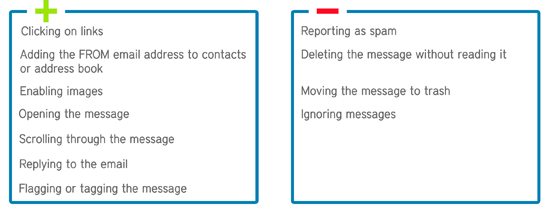
So you’ve been through all the deliverability tutorials and you have implemented all the recommended best practises. The emails should land in the Inbox and your job is done!
Not so fast…
It is just as important to ensure that customers are reading and engaging with your email messages. Why? Many ISPs use engagement as a measure of whether or not an email is in fact wanted by their customer base. No engagement means you could land up in the junkmail folder.
Engagement measures the customers’ responses and interactivity with email messages. Engagement can either be positive (+) or negative (-). Together with your ISP, you can now evaluate engagement in a way that essentially asks the question: Are these emails valuable – and should we allow them into inboxes?

- Set & maintain expectations Set up expectations around what customers will be receiving. This can be done in the welcome email when they sign up. Then do exactly what you said you were going to.
- Provide relevant content Send segmented messages based on preferences, performance or history – it shows customers that you are listening.
- Reply address Make sure you have a working reply address, as replies to emails count towards engagement. Implement an auto-responder if replies cannot be monitored.
- Subject lines and pre-headers The subject line is the first point to pique the customers’ interest and get them to open the email. This copy should reflect the content and attention grabbing.
- Content The key to high engagement metrics is relevancy. Your content has to be relevant and valuable to recipients or they simply won’t open or read your emails.
- Mobile device support Make sure customers are able to engage with your emails easily on all devices. If they can’t read it, they’ll just delete it.
- Good hygiene Remove all undelivered email addresses from your list. A high bounce rate to a particular domain, could be confused for spam sent to a bought list.
- Re-engage inactive customers Create periodic re-engagement campaigns for inactive users.
Aim for the following metrics:
- Unique open rate above 6%
- Click-to-open-rate (CTOR) of 20%
- Hard bounces below 1% – ideally below 0.25%
- Spam complaint rate below 0.1% – ideally below 0.05%
Engagement activity is already influencing several areas of email:
- Deliverability: If your customers are well engaged with your messages, you will see more benefit from your email efforts. The more they interact, the better your deliverability.
- Inbox placement: Gmail’s Priority Inbox uses engagement to tag order of importance and sorts emails based on user behavior. It automatically identifies important emails based on which have been replied to or marked as important.
Give your customers what they want, when they want it. Compelling and well-designed content is paramount to creating immediate interest and long-term engagement.
Improve the customer experience with secure document delivery today














